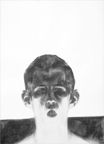KELLY WRITERS HOUSE
PAFA
at PENN
JAN 14
through
FEB 9
About
the PAFA at Penn program
PAFA at Penn is an exhibition of artworks by students
from the Pennsylvania Academy of Fine Arts who are enrolled in classes
and pursuing a Bachelor of Fine Arts degree at the University of Pennsylvania.
This is a unique program administered through the College of General Studies
that allows for simultaneous studies at both America’s first art
school and museum and America’s first university. PAFA offers an
extremely intimate art education environment with under three hundred
students practicing painting, sculpture, and printmaking. Many of these
students elect to pursue academics in addition to the rigorous art curriculum.
The transition from PAFA to Penn can be challenging primarily due to a
lack of integration into the broader Penn community. This exhibit at the
Kelly Writers House is a first of many steps to increase the exposure
of PAFA student artists to the University at large.
SPEAKING
AN IMAGE
By Peter Schwarz, Curator
We should apologize for daring to speak about painting
~Paul Valery
I cannot heed Valery’s words despite the implicit charge
of transgression and violation—one commentator voicing over another,
the writer daring to speak for the artist as if the work were not enough
to reach the senses. Nothing could be further from the truth: presented
in the space of the Kelly Writers House, a space itself which recreates
the early modernist days when the salon reigned as happening, this collection
is a testament both to the Pennsylvania Academy’s eminence in training
extraordinary artists and the power of art to seep into the human consciousness
in subtle, profound ways that often equal revelations. This exhibit presents
artists and works too numerous for commentary beyond those following this
introduction, though every work indicates great possibilities. Each work
represents an artist during various stages on that journey through the
human experience, and I offer these words as an homage while privately
(and now publicly) lamenting the meagerness of my own craft.
The fragility of words is exposed, words fall away from
the sublime, in the face of the self-portrait of Mary E. Harju.
Neither reflecting an ordinary exercise of portraiture nor presenting
an act of ego, “Self-Portrait in the Studio” reveals the elements
of Harju’s contradictory spirit in both physical and psychological
terms—mad beautiful grace, fear, pride, strength of purpose, fragility,
dignity, love—presenting herself before herself as if she were suddenly
caught by surprise, poised in fierce dignity on the edge of infuriation
for the intrusion. Is it a courageous introspection, a confrontation of
personas? Is it an act of purgation? Or the declaration Je suis comme
ca! Subtle currents run strong in the depths of passion. “Self-Portrait
in the Studio” restores to the genre what is so often lacking in
many, more frivolous portraits: honesty and courage, the ability to lure
out the subject’s interior without compromising the subject’s
facade and extending it to the mood of the subject’s environment.
The high standard of portraiture extends to Kate
Fraser’s “Unappreciated”. Set in a faded aura, the
little princess stands before the viewer strikingly real, this lonely
wounded girl wrenching the heart, causing the viewer to wish for the power
to heal the girl’s wounds and restore her magnificent colors. The
three studies of sculptor Mark Utreras are executed by the detailed
eye and precise hand of a sculptor whose complex sense of perspective
in “After Prud’hon” nearly creates a sculpture on paper.
Utreras renders the model’s form in a manner approaching the sublime.
Magy Miller’s untitled portrait of a strong and sinister
man evokes impressions of a serious caricature, the man as a thief, liar,
swindler, pernicious seducer of naïve women who swoon before his
swarthiness, all personalities as a comical exaggeration recalling childhood
cartoons. Erich Estes’ untitled charcoal on paper, drawing
on influences of Munch’s “The Scream”, speaks The horror! as
the subject witnesses an astounding crime or tragedy defying comprehension,
darkening consciousness. Estes reduces the magnitude of extreme incomprehension
to existentialist essentials, revealing a cold interior approaching Beckett’s
absurd.
The several three dimensional pieces are led by Adam
Presti’s “River God” and Hisako Inoue’s
“Do I know You?”. Presti’s terra cotta sculpture with blue
highlights gives life to a mythical figure and depicts the strength and
wild power of a god caught in human form; perhaps unable to renounce his
human existence, the god’s heavy eyes and collapsed posture suggest
a profound melancholy. In strong contrast is Inoue’s rubber piece:
a fascinating, fun, playful work that draws the viewer closer, Inoue contributes
an example of Japanese artistic comedy. Delightfully pure in its minimalism,
the viewer’s imagination is invited to participate, maybe imagining
this as a model for a much larger, floor installation piece of performance
anime.
Now I heed Valery’s words.
